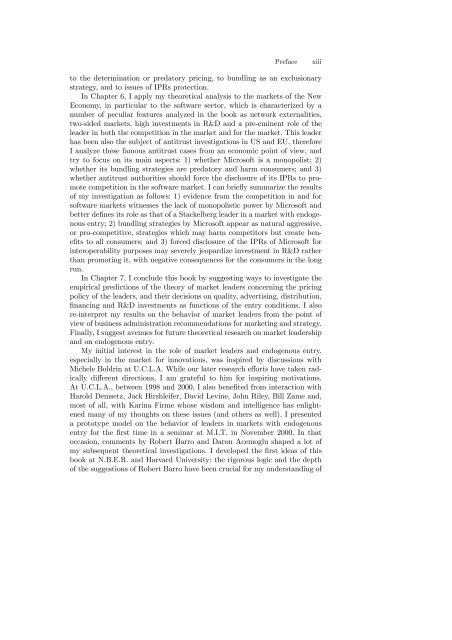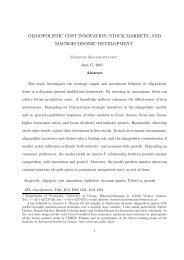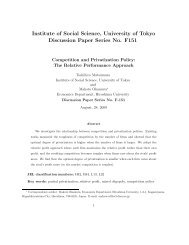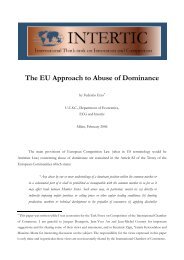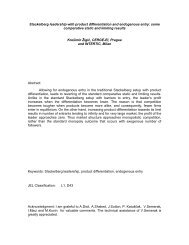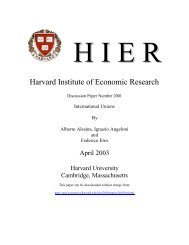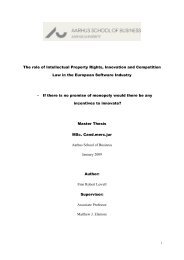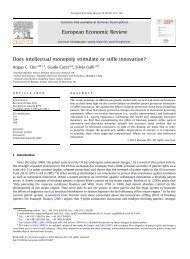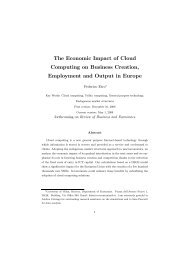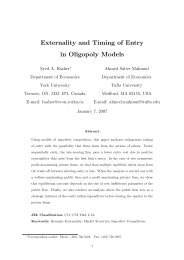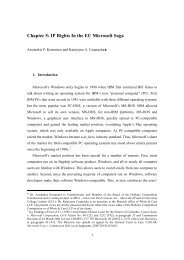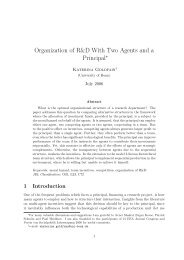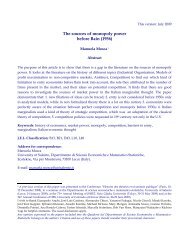Competition, Innovation, and Antitrust. A Theory of Market ... - Intertic
Competition, Innovation, and Antitrust. A Theory of Market ... - Intertic
Competition, Innovation, and Antitrust. A Theory of Market ... - Intertic
You also want an ePaper? Increase the reach of your titles
YUMPU automatically turns print PDFs into web optimized ePapers that Google loves.
Preface<br />
xiii<br />
to the determination or predatory pricing, to bundling as an exclusionary<br />
strategy, <strong>and</strong> to issues <strong>of</strong> IPRs protection.<br />
In Chapter 6, I apply my theoretical analysis to the markets <strong>of</strong> the New<br />
Economy, in particular to the s<strong>of</strong>tware sector, which is characterized by a<br />
number <strong>of</strong> peculiar features analyzed in the book as network externalities,<br />
two-sided markets, high investments in R&D <strong>and</strong> a pre-eminent role <strong>of</strong> the<br />
leader in both the competition in the market <strong>and</strong> for the market. This leader<br />
has been also the subject <strong>of</strong> antitrust investigations in US <strong>and</strong> EU, therefore<br />
I analyze these famous antitrust cases from an economic point <strong>of</strong> view, <strong>and</strong><br />
try to focus on its main aspects: 1) whether Micros<strong>of</strong>t is a monopolist; 2)<br />
whether its bundling strategies are predatory <strong>and</strong> harm consumers; <strong>and</strong> 3)<br />
whether antitrust authorities should force the disclosure <strong>of</strong> its IPRs to promote<br />
competition in the s<strong>of</strong>tware market. I can briefly summarize the results<br />
<strong>of</strong> my investigation as follows: 1) evidence from the competition in <strong>and</strong> for<br />
s<strong>of</strong>tware markets witnesses the lack <strong>of</strong> monopolistic power by Micros<strong>of</strong>t <strong>and</strong><br />
better defines its role as that <strong>of</strong> a Stackelberg leader in a market with endogenous<br />
entry; 2) bundling strategies by Micros<strong>of</strong>t appear as natural aggressive,<br />
or pro-competitive, strategies which may harm competitors but create benefits<br />
to all consumers; <strong>and</strong> 3) forced disclosure <strong>of</strong> the IPRs <strong>of</strong> Micros<strong>of</strong>t for<br />
interoperability purposes may severely jeopardize investment in R&D rather<br />
than promoting it, with negative consequences for the consumers in the long<br />
run.<br />
In Chapter 7, I conclude this book by suggesting ways to investigate the<br />
empirical predictions <strong>of</strong> the theory <strong>of</strong> market leaders concerning the pricing<br />
policy <strong>of</strong> the leaders, <strong>and</strong> their decisions on quality, advertising, distribution,<br />
financing <strong>and</strong> R&D investments as functions <strong>of</strong> the entry conditions. I also<br />
re-interpret my results on the behavior <strong>of</strong> market leaders from the point <strong>of</strong><br />
view <strong>of</strong> business administration recommendations for marketing <strong>and</strong> strategy.<br />
Finally, I suggest avenues for future theoretical research on market leadership<br />
<strong>and</strong> on endogenous entry.<br />
My initial interest in the role <strong>of</strong> market leaders <strong>and</strong> endogenous entry,<br />
especially in the market for innovations, was inspired by discussions with<br />
Michele Boldrin at U.C.L.A. While our later research efforts have taken radically<br />
different directions, I am grateful to him for inspiring motivations.<br />
At U.C.L.A., between 1998 <strong>and</strong> 2000, I also benefited from interaction with<br />
Harold Demsetz, Jack Hirshleifer, David Levine, John Riley, Bill Zame <strong>and</strong>,<br />
most <strong>of</strong> all, with Karina Firme whose wisdom <strong>and</strong> intelligence has enlightened<br />
many <strong>of</strong> my thoughts on these issues (<strong>and</strong> others as well). I presented<br />
a prototype model on the behavior <strong>of</strong> leaders in markets with endogenous<br />
entry for the first time in a seminar at M.I.T. in November 2000. In that<br />
occasion, comments by Robert Barro <strong>and</strong> Daron Acemoglu shaped a lot <strong>of</strong><br />
my subsequent theoretical investigations. I developed the first ideas <strong>of</strong> this<br />
book at N.B.E.R. <strong>and</strong> Harvard University: the rigorous logic <strong>and</strong> the depth<br />
<strong>of</strong> the suggestions <strong>of</strong> Robert Barro have been crucial for my underst<strong>and</strong>ing <strong>of</strong>


